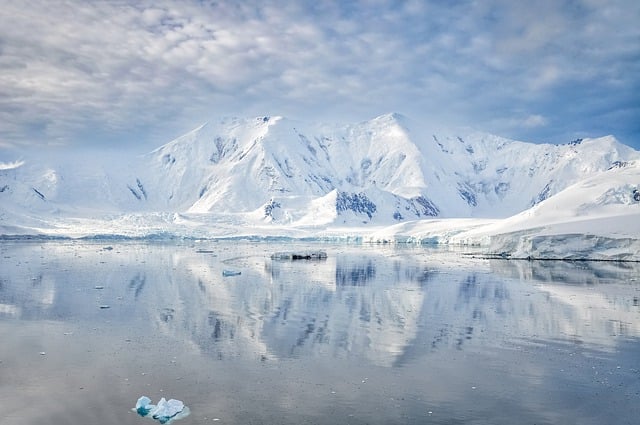Slowly but surely, Antarctica’s “Doomsday Glacier” is crumbling apart as the cracks on its surface grow with every passing year. The massive glacier — about the size of Florida — now teeters on the brink of collapse, which would cause the sea level to surge 11 feet higher. But before everything falls to pieces, researchers are racing to measure how quickly the glacier is fracturing.
A new method to evaluate cracks across the Doomsday Glacier has already revealed some valuable details, shared in a study from the Journal of Geophysical Research: Earth Surface. Using recent satellite data, researchers have honed in on the underlying factors that are chipping away at the glacier’s surface.
A Cracked Shield
The Doomsday Glacier (officially known as the Thwaites Glacier) has been melting at an intensifying pace in recent years, unsettling many climate scientists. It is currently losing about 50 billion tons of ice every year, contributing to 4 percent of sea level rise. But an even greater danger justifies the glacier’s chilling nickname.
The glacier acts as a barricade for the West Antarctic Ice Sheet, a region that sits in a basin below sea level in Western Antarctica. The collapse of the Doomsday Glacier would essentially open the floodgates, causing the ocean to fill the basin and accelerate ice loss.
Scientists know the Doomsday Glacier is in danger, but conflicting studies on its instability have muddled the picture. A May 2024 study presented satellite radar data to show that the glacier was experiencing “vigorous melting” due to warm tidal currents flowing under the ice. But a separate August 2024 study offered a potential silver lining — researchers claim that ice cliffs on the glacier could stabilize in the future based on three ice sheet models.
Read More: As Glaciers Retreat, Powerful Volcanoes May Erupt More Frequently Across the Planet
Making Sense of Glacier Fractures
The complexity of cracking on the Doomsday Glacier only adds to the general uncertainty. Simplified models, limited data on ice fracturing, and the difficulties of making field observations have made it challenging for scientists to truly get a grasp of the glacier’s surface.
The researchers involved with the recent study say that the status of the Thwaites Ice Shelf, an extension of the glacier, is particularly tricky to track because of rapid changes and fast ice flow.
“We’ve seen ice shelves break off, but we’ve never seen one grow back,” said co-author Richard Alley, a geologist at Pennsylvania State University, in a statement. “This new research indicates we can predict better the point at which these will break off. It’s helping to establish the early-warning signals.”
The new method of examining glacier cracks, however, has finally brought some progress. Researchers referenced data collected by NASA’s ICESat-2 from 2018 to 2024 to develop a workflow that could measure glacier fracturing over time. This process uses high-resolution profiles of surface elevations and visual cross-sections of the fractures to reveal a range of fracture types and characteristics.
An Uncertain Future
The researchers found that the eastern part of the Thwaites Ice Shelf is undergoing more aggressive fracturing, while the western part is more stable in comparison. They haven’t settled on a reason for this disparity, but the fracturing in the east may be linked with warmer winter air, reduced sea ice, and changes in the ocean circulation beneath the ice shelf.
The question of how to deal with the fracturing has scientists contemplating the best course of action. Some have proposed large-scale glacier geoengineering projects to build structures that would keep glaciers standing, but these ideas would have major financial and logistical constraints. Regardless, it will be necessary to keep a close eye on the Doomsday Glacier. Previous research has suggested that parts of the glacier could fall within the next decade, although a full collapse may not happen for 200 years.
“We believe that if the Thwaites Glacier gets very unstable, it will have catastrophic consequences,” said lead author Shujie Wang, a professor of geography at Pennsylvania State University. “It’s an important area to be studied, to say what’s going to change next.”
Read More: Ice Quakes Cause Glacial Ice to Flow Toward the Ocean
Article Sources
Our writers at Discovermagazine.com use peer-reviewed studies and high-quality sources for our articles, and our editors review for scientific accuracy and editorial standards. Review the sources used below for this article:
-
NASA Earth Observatory. Thwaites Glacier Transformed
-
PNAS. Widespread seawater intrusions beneath the grounded ice of Thwaites Glacier, West Antarctica
-
Science Advances. The West Antarctic Ice Sheet may not be vulnerable to marine ice cliff instability during the 21st century
Jack Knudson is an assistant editor at Discover with a strong interest in environmental science and history. Before joining Discover in 2023, he studied journalism at the Scripps College of Communication at Ohio University and previously interned at Recycling Today magazine



